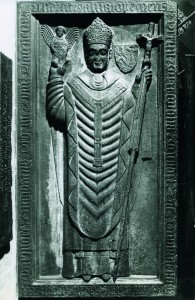Wills as historical sources
Published in Uncategorized The law dictated who could make a will or testament and what form the document took. The practice of writing testaments arrived in Ireland with the Anglo-Normans. Testaments allowed people to dictate instructions for their funeral, appoint executors and dispose of their ‘moveable’ property—their possessions with the exception of land or houses, which were passed down according to the general rules of inheritance. Only with the appearance of wills in the late fourteenth century could people determine to whom their lands would pass. Under medieval law, a married woman didn’t have legal rights and responsibilities independent of her husband’s—the law took the scriptural injunction that the two become one flesh quite literally—and so a woman could only make a will or testament subject to her husband’s approval. Most medieval women never left wills, making the 29 female-authorised wills in the Register a striking presence. A married man could bequeath personal property without his wife’s approval, but only half of it if they had no children or one third if they did. In an age before social welfare, this restriction ensured that the family of the bereaved wasn’t left totally destitute. We must keep these restrictions in mind when using wills as a measure of people’s interests, just as we must remember that the survival of wills is patchy and that only those with property to leave and an awareness that they were dying were liable to write one. The Register’s wills survive only because probate at an episcopal court was needed to validate a will.
The law dictated who could make a will or testament and what form the document took. The practice of writing testaments arrived in Ireland with the Anglo-Normans. Testaments allowed people to dictate instructions for their funeral, appoint executors and dispose of their ‘moveable’ property—their possessions with the exception of land or houses, which were passed down according to the general rules of inheritance. Only with the appearance of wills in the late fourteenth century could people determine to whom their lands would pass. Under medieval law, a married woman didn’t have legal rights and responsibilities independent of her husband’s—the law took the scriptural injunction that the two become one flesh quite literally—and so a woman could only make a will or testament subject to her husband’s approval. Most medieval women never left wills, making the 29 female-authorised wills in the Register a striking presence. A married man could bequeath personal property without his wife’s approval, but only half of it if they had no children or one third if they did. In an age before social welfare, this restriction ensured that the family of the bereaved wasn’t left totally destitute. We must keep these restrictions in mind when using wills as a measure of people’s interests, just as we must remember that the survival of wills is patchy and that only those with property to leave and an awareness that they were dying were liable to write one. The Register’s wills survive only because probate at an episcopal court was needed to validate a will.
















